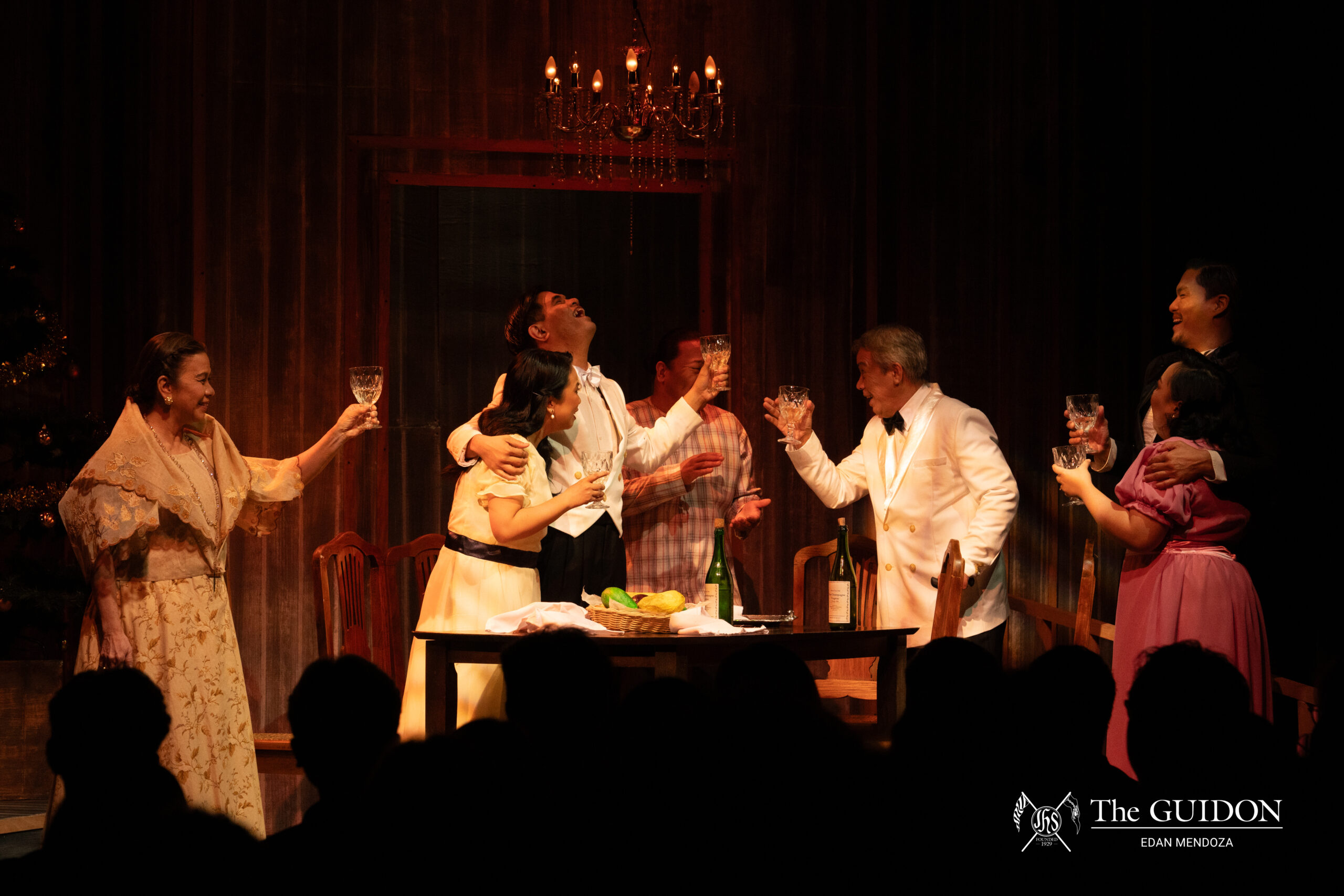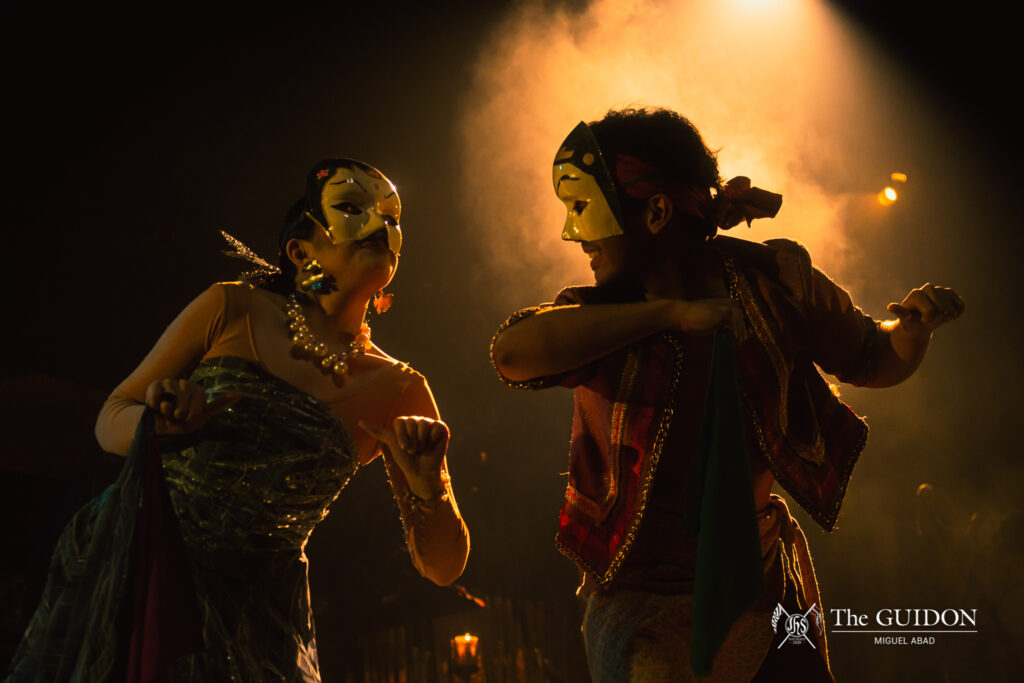TRAVEL BACK in time to the year 1942 in the Philippines, a period in our history that has been blood-marked by the Japanese occupation and the fierce struggle of the Filipino people. Ateneo ENTABLADO’s Sa Tahanan ng Aking Ama vividly portrays family hardships during this period of conflict, a nation’s submission to foreign power, and the brutal realities of war. Throughout the show’s two-hour and 30-minute runtime, betrayals, defiances, and the looming presence of death are served to the characters on a scathed, rusty platter.
Created for the stage by Elsa Coscolluela, with the translation and direction of Jerry C. Respeto, the production follows the involvement of the Santamaria family during the Japanese colonial period. The family is confronted with a harsh shift in reality as authority and protection falter, divisions arise from conflicting beliefs, and Filipino oppression intensifies—all contributing to the increased complexity of maintaining family bonds.
Moreover, the challenges faced within the Santamaria household transcend mere family troubles as they powerfully illustrate the stark realities of a nation’s crisis under colonialism.
Where love lies
The production opens with a celebratory feast at the Tahanan (house). Amid the warmth of the festivities, Carlos Santamaria (Jethro Tenorio) embodies the role of the Ama (father), representing authority and protection over his family. Behind him stands his wife Amanda (Katski Flores), the emotional arm of the household, ensuring that family is prioritized above all.
Together, the two create a home filled with love, where family always comes first. Their home shelters their two sons, Miguel (Gino Ramirez) and Franco (Vino Mabalot), along with their wives. With their youngest son, Carlito, serving as a medic, the other two brothers are called out to fight as the war escalates, leaving Carlos and Amanda to manage the household on their own.
Carlos proves his role as a noble husband and the man of the house amid the emotional turmoil that ensued. As a father, he shields his family from harm when Japanese soldiers forced their way into their home, positioning himself as a barrier between his loved ones and the looming threat of violence. Despite the tension and fear that fill the household, Carlos remains resolute, unwavering in his determination to preserve the safety and dignity of his Tahanan in the face of foreign occupation.
Meanwhile, the portrayal of women in the production reflects their domestic responsibilities, signifying their role as pillars of colonial Filipino society. Amanda Santamaria’s (Katski Flores) motherly persona, consumed by overbearing care for the safety of her sons, evokes deep empathy from the audience.
Amanda just wants her family together, and she expresses it with such powerful cries and arguments. To depict the sacrifices women make to keep families intact, we witness the struggles of Miguel’s wife Isabel, (Bea Jose), as she returns to their farm to look after their children.
The separation and absence of her husband take a heavy toll on her, although she tries her best to persevere. On the contrary, Franco’s wife Christy (Chase Salazar) stays with the Santamaria family, with her days filled with worry for her husband and her own foster family from a distance.
Though the family’s journey may be marked with stains of trials and sacrifice, each ordeal only brings them closer together. The Santamaria household, which realistically portrays a true Filipino family, centers on love as the core foundation for their survival.
A schism between heroes
While the rest of the family faces their own battles, the two brothers clash over their conflicting ideologies regarding the war. These disagreements end up creating a rift not only between the brothers but within their entire family, representing the internal conflicts that many families faced during testing times.
The rivalry between Miguel and Franco stems from their opposing views on how to approach the war. Miguel believes in waiting for the American forces to liberate the Philippines, while Franco, lacking patience, feels the need to take immediate action. The burden of being the family’s “men of war” falls on the two brothers, leading to them frequently clashing over the motives and events of the Japanese occupation.
As a lawyer and professor, Miguel approaches the war straightforwardly, leading him to fight alongside the Philippine guerrillas. Ramirez’s portrayal of Miguel accentuates his nationalistic nature, highlighting his faith in American intervention and his unwavering dedication to the cause of liberation as an established Filipino citizen.
In contrast, Franco is a politician with an idealistic yet conflicted mindset. His views on the Japanese occupation are blurred, torn between fighting for his country or acting as a puppet under Japanese rule. With this, Mabalot’s portrayal perfectly captures his compliant nature, leaving the audience torn between empathy and distrust for his character’s actions of “betrayal.”
Despite their differing ideals and methods, both brothers can be seen as heroes in their own right, embodying different forms of heroism under the pressures of war. Miguel sacrifices for his family, leaving his wife and children to fight as a guerrilla, while Franco, under coercion, becomes a governor serving the Japanese.
While their paths diverge, they ultimately represent two sides of the same coin—both driven by love for their family and country, as well as yearning for freedom from the sacrifices of war. Their struggle with loyalty, survival, and responsibility mirrors the broader societal battle between submission and defiance during the Japanese occupation.
Their misunderstandings transcend sibling rivalry, addressing the broader themes of wartime movements and personal responsibilities. The loyalty between the two brothers may seemingly lie between two different nations, yet their actions have one clear and common goal: Philippine independence.
The war unfiltered
Through its meticulously designed set, period costumes, evocative lighting and props, and the inspiring performances of the actors, Sa Tahanan Ng Aking Ama masterfully transports the audience back to the era of Japanese colonization. The set spotlighted the Tahanan itself, engulfing the audience with a first-hand glimpse of the characters’ lives shaped by wartime memories.
Two projector screens were used to display public service announcements and mark the passage of time, illustrating key moments in the war as the play progresses. These visuals anchor the audience in the historical context, deepening their understanding of the unfolding events and their significance within the storyline.
Complementing these historical visuals, the actors breathe life into the story, skillfully portraying the emotional turmoil each character endures. Although there is still potential for refinements in line delivery and mastery, the cast effectively captures the profound struggles of a family during colonial rule, while also featuring the broader horrors of war. Their performances powerfully convey the weight of both personal and historical afflictions, driving home the show’s central theme.
Another commendable aspect of the production is its dedication to authentically capturing the documented terrors of war through bold yet necessary plot points. Marisa (Chantei Cortez), a beautiful woman in an era of exploitation, loses all personal ownership of her flesh and bones. Cortez’s performance convincingly delivers the fragility and heft of suffering, leaving the ominous spirit of agony hanging over the audience’s heads. The sorrowful atmosphere surrounding her character amplifies the tension of the show, setting the stage for the impending resolution of the disappearance of the family’s youngest son, Carlito.
Ironically, despite his role as a medic, Carlito’s life is claimed by the very lack of medical resources meant to save him. This loss becomes the breaking point for Amanda, plunging her into deep sorrow as she longs for the war to end, yearning for the simple hope of reuniting her family and ensuring their safety once more.
Set against this heartbreaking backdrop, ENTABLADO’s Sa Tahanan ng Aking Ama remains a powerful production that delves into countless trials of loyalty, life-altering sacrifices, and the profound costs of survival. The weight of personal and political struggles during the Japanese occupation rests heavily on the shoulders of each character, making each subplot equally as vital in weaving together a compelling narrative.
Collectively, the Santamaria family reminds us that although times of conflict can tear apart even the strongest bonds, blood will always be thicker than water. Their unwavering loyalty and protection for one another continually served as their compass throughout the whirlwind of conflict they each endured.
As the curtain falls, the audience is left with an undeniable truth: love and survival come with a price, leaving scars that run far deeper than the ones obtained on the battlefield.






